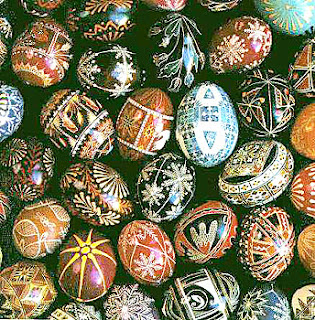It's pretty much common knowledge that Easter is a Christian celebration of Christ's rising, but this holiday also has pagan origins. Where did the colored eggs, cute little bunnies, baby chicks, leg of lamb dinners, and lilies come from? They are all symbols of rebirth and the lamb was a traditional religious sacrifice.
Easter falls in the spring, the yearly time of renewal, when the earth renews itself after a long, cold winter. The word Easter comes to us from the Norsemen's Eostur, Eastar, Ostara, and Ostar, and the pagan goddess Eostre, all of which involve the season of the growing sun and new birth. The Easter Bunny arose originally as a symbol of fertility, due to the rapid reproduction habits of the hare and rabbit.
The ancient Egyptians, Persians, Phoenicians, and Hindus all believed the world began with an enormous egg, thus the egg as a symbol of new life has been around for eons. The ancient Persians painted eggs for Nowrooz, their New Year celebration falling on the Spring Equinox. This tradition has continued every year on Nowrooz since ancient times. At the Passover Seder, a hard-boiled egg dipped in salt water symbolizes both new life and the Passover sacrifice offered at the Temple in Jerusalem.
The particulars may vary, but most cultures around the world use the egg as a symbol of new life and rebirth. A notation in the household accounts of Edward I of England showed an expenditure of eighteen pence for 450 eggs to be gold-leafed and colored for Easter gifts. The first book to mention Easter eggs by name was written five hundred years ago. Yet, a North African tribe that had become Christian much earlier in time had a custom of coloring eggs at Easter. Long hard winters often meant little food, and a fresh egg for Easter was quite a prize. Later, Christians abstained from eating meat during the Lenten season prior to Easter. Easter was the first chance to enjoy eggs and meat after the long abstinence.
Some European children go from house to house begging for Easter eggs, much like Halloween trick-or-treaters. Called pace-egging, it comes from the old word for Easter, Pasch. Many old cultures also attributed the egg with great healing powers. It is interesting to note that eggs play almost no part in the Easter celebrations of Mexico, South America, and Native American Indian cultures. Egg-rolling contests are a symbolic re-enactment of the rolling away of the stone from Christ's tomb. The decoration of small leaf-barren branches as Easter egg trees has become a popular custom in the United States since the 1990s.
Happy Easter from Paula and Matt at MI Printing!

